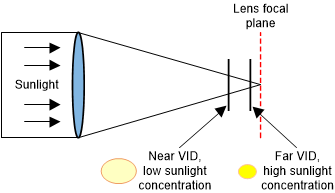TIDUEE5A October 2018 – May 2022
- Description
- Resources
- Features
- Applications
- 5
- 1System Description
- 2System Overview
- 3Hardware, Software, Testing Requirements, and Test Results
- 4Design Files
- 5Software Files
- 6Related Documentation
- 7Terminology
- 8Revision History
2.4.1.3 Virtual Image Distance
VID is a very important system design parameter. It does not have a large effect on required brightness, but it drastically changes the solar loading of the imager. AR HUDs perform well with longer virtual image distances, 7.5 m and above. This allows the displayed image to conformally overlay information on the road and cars in front of the driver for a seamless image. These long virtual image distances collect and focus more sunlight back into the HUD system. This solar load can cause problems with absorptive display devices such as TFT panels, increasing the temperature beyond rated conditions. A DLP3030-Q1 based projection system uses a transmissive diffuser screen to create the displayed image. Sunlight collected and incident on this screen is both transmitted and dispersed, minimizing temperature rises of the screen and reducing light concentration on the optics behind the screen. This enables a DLP3030-Q1 based HUD design to support a VID > 15 m.
For more information on the effects of solar load and virtual image distance, please see DLP® Technology: Solar loading in augmented reality head-up display systems white paper.
 Figure 2-5 Increased Sunlight
Concentration With a Longer Virtual Image Distance
Figure 2-5 Increased Sunlight
Concentration With a Longer Virtual Image DistanceThe brightness, resolution, and long virtual image distances enabled by the DLP3030-Q1 DMD and chipset allows for HUD systems with bright images, large eyeboxes, and sharp displays.